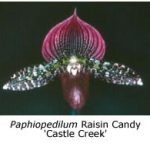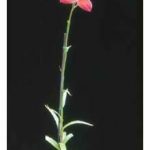Most readers will now be familiar with the terms genus (plural genera) and species when it comes to naming orchid species. The genus name represents a group of closely related plants, while the species epithet is used to distinguish one member of that group from another. For example, we have the genus Laelia and the individual species Laelia anceps and Laelia gouldiana as two of its members. Note that there are only two words, and that both are italicised; the first letter of the genus name is the only one in capitals. It’s important to follow this convention, as it enables us to distinguish species orchids from hybrids simply by the way their names are typed.
Many orchid hybrids also have two terms, although some have three or even four. The genus is typed in the same way as with species orchids (and is also italicised) but the second and subsequent terms (if used) must also begin with a capital letter and must not be italicised. As examples, we can cite Cymbidium Jubilation, Paphiopedilum Raisin Candy and Maclellanara Pagan Love Song. The names of these hybrids are all registered with the Royal Horticultural Society (UK) and are the only ones that may be used for these particular hybrids.
Occasionally you will see orchids (both species and hybrids) with names carrying additional terms in inverted commas. Examples are Paphiopedilum insigne ‘Harefield Hall’, Cymbidium Second Renaissance ‘Jenny Wren’ and Masdevallia Pichincha ‘Eruption’. The names in inverted commas are cultivar names that have been conferred by the original owner of these particular plants. While you may apply a cultivar name to a seedling that you have raised yourself, you should not replace an existing cultivar name with another, or give your orchid the same cultivar name as another of the same species or hybrid grex.
For preference, only outstanding orchids should be given cultivar names. All orchids that have received awards from OSCOV (or other orchid judging bodies) must carry a cultivar name. An example that springs to mind is Disa Kalahari Sands ‘Santa Claus’ HCC/OSCOV. The choice of a new cultivar name is entirely up to the grower, although there are a few conventions, such as not naming it after one’s self (the name of a family member is OK) or promoting it in the eyes of the judges with a cultivar name such as ‘Magnifica’.
These are current conventions, however, and not applied in the past, as a few examples of species orchids that were awarded a century or more ago will show – Laelia anceps ‘Chamberlainiana’ (or Chamberlain’s variety), was named after its owner, the British parliamentarian Joseph Chamberlain, while Laelia anceps ‘Williamsiana’ was named by Benjamin Williams, nurseryman and author of the most widely read orchid book during the nineteenth century {The Orchid-Grower’s Manual).
Other well-known plants were named after the estates of their owners – for example, Paphiopedilum insigne ‘Harefield Hall’ and Cymbidium Alexanderi ‘Westonbirt’. Paphiopedilum insigne ‘Sanderae’ was named by its owner (Frederick Sander) in honour of his wife (the cultivar name would be ‘Sanderianum’ if the orchid had been named after Sander himself).
Until recently it was not possible to register cultivar names but in the past year or two a few species orchids of special value in hybridising have had their cultivar names recognised by the Royal Horticultural Society.



